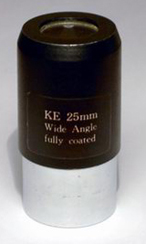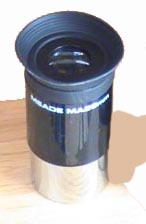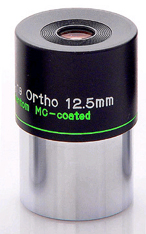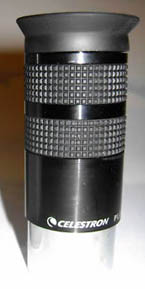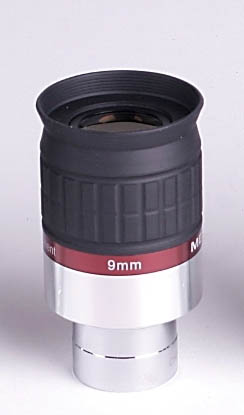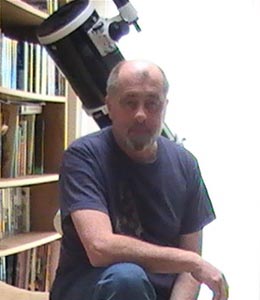Part
One: Introduction - What are eyepieces for?
Telescopes
don't work without an appropriate eyepiece with which to view with, and this immediately
makes the eyepiece a very important part of the construction of the telescope,
in fact, it is the other half of a very finely tuned optical system that has been
developed over hundreds of years.
However, advances in technology over
the past 150 years has set the scene for a number of choices that may be made
by the amateur astronomer, based on the construction and the quality of the optics
themselves.
But what are these choices, and how can the ordinary person
in the street (in this case a person new to amateur astronomy) decide on what
eyepiece to buy and what performance it is likely to yield?
But I had
some eyepieces with my new telescope!
It is perhaps a travesty to learn
that with your first telescope that you may have spent two or three hundred pounds
for came with eyepieces that are barely fit for purpose, and even the well established
manufacturers provide only the most basic specification eyepieces with which to
start.
This is such a shame as many a budding amateur astronomer may be
put off at the very first hurdle because the quality of the image is both poor
and lacks the expected clarity that buying a worthy telescope called for in the
first place.
There are probably two reasons for this, one is that the making
of Optical Tube Assemblies (OTA's) i.e. the telescope itself, is relatively cheap
by comparison and the quality of a scope is found here in the first instance,
and not in the eyepieces themselves.
The second is that the manufacturer
may want to elicit future sales by getting you to buy the various eyepieces and
any extras at a future date. Of course, the manufacturer will argue that this
gives the consumer more choice. However, this is not good practice for those setting
out on this great new adventure in my view.
So what can you expect with
a new telescope?
You will most likely get at least two eyepieces, these
are usually of a 25mm and 10mm focal length, one for viewing wide sky (25mm) such
as star clusters and galaxies, and one for viewing the Moon and the planets (10mm)
and gives you, with greater maginification the detail needed to say, view craters
on the Moon. However, some manufacturers will only supply the 25mm with your new
scope, and it is certain that you will soon get bored with this limited choice.
Of the most popular telescope manufacturers, Sky Watcher perhaps supplies
the better 'starter' eyepieces with their Super Wide 25mm & 10mm eyepieces,
some telescopes (Meade in particular) come with a set of five MA (Modified Acromat)
eyepieces and this is really good for the beginner, and many people swear by this
first set of eyepieces.
Celestron on the other hand tend to supply eyepieces
which unfortunately leave a lot to be desired. The eyepieces often come with the
following identifing features: SR4 , H12, K20. The letters refer to the eyepiece
construction and are often uncoated, which means they may suffer from reflection
and chromatic abberation (false colour).
Therefore the message here is
to avoid eyepieces that start with these initial letters as they are not particularly
good, and you should consider replacing them as soon as possible. Notes on what
to upgrade to are given below.
| 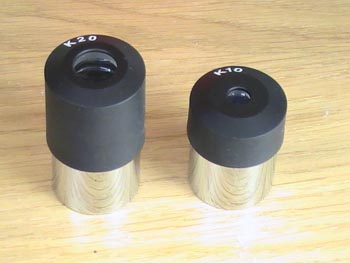 The
eyepieces above are those that come with the The
eyepieces above are those that come with the
cheaper range of telescopes and
are based on Carl
Kellner's 3-lens design that includes an acromatic
doublet
(note the designation 'K')
| 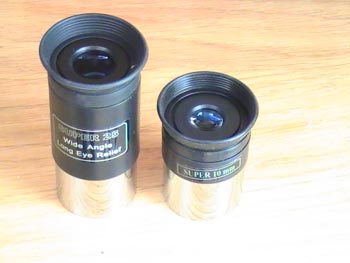 The
Sky Watcher basic eyepieces, the Super 10 and the The
Sky Watcher basic eyepieces, the Super 10 and the
Super 25 are actually quite
good starter eyepieces,
with good eye relief but lack contrast - based
on
a modified acromat (similar to a Kellner)
| 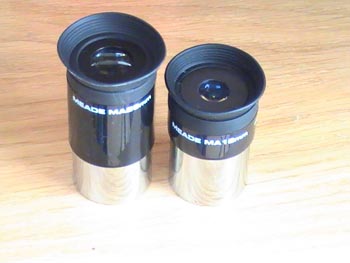 The
Meade modified acromats (designated MA) are again The
Meade modified acromats (designated MA) are again
good 3-element starter eyepieces, they are often dispatched as
part of a boxed set of five eyepieces. |
Recap...
Not
all starter eyepieces are of the best quality, it is therefore best to always
seek advice when thinking about upgrading eyepieces. Eyepieces are a really important
part of the telescope - the other half of what is in effect a finely tuned scientific
optical instrument, so if the eyepieces are not also of a fine standard your enjoyment
will be affected.
When thinking about upgrading seek the advice of others,
or get advice from the specialist shop you bought your new telescope from (rather
than a high street store). Better still, join an astronomy group and talk to others,
and view through their telescopes to get a better understanding of what different
eyepieces have to offer. |
Part
Two: Things to consider when buying a new eyepiece
Barrel
Diameter
It is very important that you check
the barrel diameter of the eyepiece that your telescope accepts, in most cases
you will find that it takes only one size and this is usually 1¼"
(31.7mm). However, eyepieces and barrel fittings come in three sizes:
- 0.965
inches (24.5 mm), this size has been largely abandoned, but are sometimes still
sold with the cheapset and nastiest scopes
- The most popular telescope eyepiece
barrel diameter is 1¼ inches (31.75 mm). Most scopes have these.
-
Telescope eyepieces with 2 inch (50.8 mm) barrels are also available, but you
must check whether your telescope will accept this larger size diameter before
considering these. If your telescope has a good sized aperture (such as reflectors
of 6" mirror or above) there is good chance that it may accept 1¼"
and 2" diameter eyepieces. Many good quality refractors
will also accept these, however SCT's and Maks very rarely unless at the high
end of the market.
What
difference does it make whether you use a 1¼"
or 2" eyepiece?
Viewing
a celestial object through a 1¼"
or 2" eyepiece of similar
quality (say an 8mm) will look exactly the same if used in the same scope where
the focal length of the scope remains constant.
However, 2" eyepieces
have the following advantages and disadvantages:
- the 2" eyepiece
will probably have better eye relief (see 'Eye Relief' below) enabling you to
look at an object for longer
- it will feel more comfortable and give you a slightly better field
of view (FOV ( see below))
- at low power 2"
eyepieces (25mm to 38mm focal lengths) are
good for deep sky observing and not so good for planetary and lunar observing.
- 2" eyepieces may not perform so well with SCT's or Maks because of
the telescopes' long focal length, making the wider field of view that the eyepiece
offers irrelevent.
- one of the biggest disadvanges of the 2" eyepiece
is their cost, with decent eyepieces in this diameter regularly starting at around
£80, more than twice the cost of a decent 1¼"
eyepiece! The
other thing is that filters for 2" eyepieces will also cost twice as much
and so on.
- 2" eyepieces tend to be heavy and may easily tip a lightweight
telescope.
Recap....
If
you would like to use 2" eyepieces with your
1¼"
diameter focuser there is nothing to stop you doing so, all you need to do is
buy a 1¼"
to 2" convertor, which costs around £20. Bear in mind that 2"
eyepieces have disadvantages as well as advantages when used with scopes and tripods
not built for the purpose.
Disadvantages:
One:
They are heavy and might tip the balance of a lighter scope.
Two: They are
at least twice the price of 1¼"
eyepieces, along with their associated filters!
Three: You will not obtain
the best field of view (FOV) that the eyepiece offers if you
are limited by the 1¼"
width of your focuser.
Advantages:
One: More comfortable
viewing and able to view for longer
Two: 2" eyepieces are good with Barlows
(clever little extension for magnifying an existing eyepiece by x2)
Three:
Eye relief is usually better (x2 normally) and so more comfortable.
Some
eyepieces come with 2" and 1¼"
fitting and give great benefits to the 1¼"
user, the most prominent of these are the Baader Hyperion range of modular eyepieces
- highly recommended at around £85 each. They also work well with Barlow
lenses. |
Elements
and groups - singlets, doublets & triplets Eyepieces
consist of several elements, 'elements' refers to the glass portion of the eyepiece,
so if an eyepiece has four elements this means that it is made up of four peices
of glass within which creates the maginification and the focal length of the eyepiece.
Some of these 'elements' are cemented together and so a doublet means two pieces
of glass cemented together and so on. Such a construction often consists of a
singlet followed by a doublet or more. One of the most popular eyepieces, the
Plössl, consists of a minimum of two doublets, for example, and may not have
a singlet eye lens, although they are getting increasingly sophisticated!
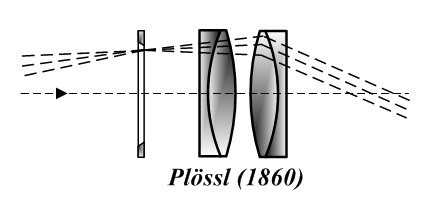 This
diagram shows a Plössl eyepiece that consists of two identical This
diagram shows a Plössl eyepiece that consists of two identical
doublets,
which are reversed, giving this eyepiece its other name of 'symetrical' |
Most
modern eyepieces are coated which helps reduce reflection and false colour.
Generally
speaking, the more elements that an eyepiece has, the better its performance should
be, providing that it is made well and originates with a good manuafacturer.
High & Low Power High
power and low power refers to the eyepiece's focal length, and the potential magnification
that can be acheived when combined with a telescope, whose focal length will also
impact. However, sticking to eyepieces, the lower the number the higher the magnification,
and the higher the number the lower the magnification. Strange that isn't it!
This is because a shorter focal length by definition will have a shorter (smaller)
number. Anyway, here is a brief comparison chart of what different focal lengths
offer:
| 2.5
- 8mm | High
magnification | Good
for planetary and lunar viewing |
| 10 - 18mm |
Medium
magnification | Good
for globular star clusters and medium detail, and some Deep Sky objects | | 20
- 32mm | Low magnification | Good
for all deep sky and feint objects including feint star clusters and nebula |
Eye
Relief
Eye
relief refers to the closness to the eyepiece that the human eye needs to be in
order to see the object being viewed, this is often called 'exit pupil'. The best
measure of this is to remember that eye-lashes are appoximately 5mm in length,
so this gives you a good idea of how to measure an eyepiece's performance in relation
to what you feel comfortable with. Eye relief is of particular concern to spectacle
wearers and in this instance the better eye relief an eyepiece offers, the better
for spectacle wearers.
However, eye relief is of interest to all astronomers
because good eye relief = comfort. The problem is that high power eyepieces do
not often give good eye relief, because greater magnification = smaller field
of view, and this in itself requires you to be viewing at a much closer range
for the pupil to engage the object being viewed, so eye relief of 2mm-5mm is about
the best you will get (remembering the eye-lashes are approximately 5mm in length).
However, in eyepieces of greater focal length (6.4mm and above) there is a
certain amount of choice that can be made by the amateur astronomer when reviewing
the eyepieces that can be chosen.
Various
eyepieces by their construction give varying degrees of eye relief, this is often
related to field of view (FOV) as for example, if an eyepiece has a narrower field
of view then inevitably the eye relief will not be as great. Consequently when
reviewing eye relief you must also consider the field of view.
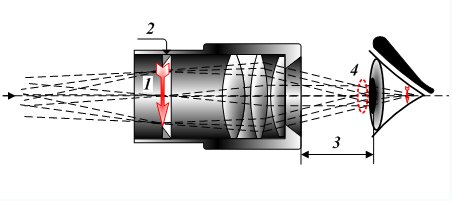 Eye
relief Eye
relief
1 - Real image 2 - Field diaphragm 3 - Eye relief 4 - Exit pupil |
| Hot Tip:
Eyepieces
with good eye relief often suffer from blacking out or 'kidney-beaning'.
This happens when the eye is viewing inside the eye relief zone
(too close), view slightly further away so that your eye is at least
at the reported distance for eye relief, it means being a little
bit patient, but this is one of the problems with eyepieces with
good eye relief, you have to view at just the right distance or
'exit pupil' - see '3' in the above diagram. Many quality eyepieces
with good eye relief have twist-up eyecups, these are invaluable
for setting the distance for the eye relief that is required for
the viewing conditions, BST Explorers are a prime example. |
FOV
(Field of View)
Actual
field of view - one tenth of a degree to 2º. Ethos - 4º Apparent
field of view - ranges from 35 to 100º
Field
of view is the apparent area of the sky that is available to see using an eyepiece,
rather than the actual field of view, which in reality is a very small part of
the sky usually. As a general rule of thumb 50º FOV and above is considered
to be good. However, when considering eyepieces this is not the only factor, because
for example, many astronomers consider a good quality orthoscoipic eyepiece to
be a good investment, yet they traditionally only have 40-45º FOV. This is
because in this particular instance the orthoscopic eyepiece is very good for
planetary and Moon studies where a narrower FOV is of some benefit (especially
in SCT's).
The
disadvantage of a 40-45º FOV is that the object you are viewing, if it is
a planet, soon goes out of your field of view and if you have a telescope without
any motor, it can be quite a challenge to keep the object centralised. If you
have a manual scope and it is a reflector, always ensure that it has been accurately
polar aligned, that way you will only have to adjust the scope on one axis
with slight turns of the slow
motion control. If you have an alt-azimuth mount then following the object as
the Earth's axis turns will prove more difficult.
Recap...
High
and Low Power, Eye Relief and Field of View are all related to one another, the
higher the power you use, the less eye relief you get, and as you move from low
to high power your field of view reduces by a proportionate amount.
When
considering what eyepieces are best for you, it is important to consider what
objects you want to view, as high power eyepieces are better for planetary and
lunar viewing and low power are better for star clusters and galaxies. Most amateur
astronomers will have a selection of both high and low power eyepieces, and some
of these will consist of different designs according to their own particular interest.
Generally speaking, the better the eye relief for a given eyepiece, the
more comfortable it becomes to observe the night sky. |
Part
Three: Eyepiece Designs
There
are eleven or twelve types of designs in eyepieces, and you can find
out more about these at Wikipedia.
Here is a short summary of the most popular eyepieces listed and described
by Wikipedia, along with a glimpse of the higher end of the market.
Kellner
or "Acromat" Carl
Kellner designed this first modern achromatic eyepiece in 1849, also called an
"achromatized Ramsden". Kellner eyepieces are a 3-lens design. An achromatic
doublet is used to correct the residual transverse chromatic aberration.
The
biggest problem of Kellner eyepieces was internal reflections. Today's anti-reflection
coatings make these usable, economical choices for small to medium aperture telescopes
with focal ratio f/6 or longer
Illustrated opposite is a Celestron 25mm
Kellner eyepiece, note designation KE, however, many Kellner eyepieces have the
single designation of 'K'. Used on the the correct aperture scope these eyepices
are simple in construction and can give good images, aperture f/6 or f/8 is better.
Price range: £12 - £16 each | | Modified
"Acromat" or standard 3-element eyepieces The
standard modified "acromat" 3-element eyepiece is similar to the Kellner
and has a FOV - 52° or better. The Modified Achromatic design has an optical
advantage over the Kellner and is often used in entry-level telescopes. The eyepieces,
sometimes marked 'MA' or similar generally have good all-round performance and
good eye relief, but lack the sharp contrasty images of 4 and 5 element designs.
The eyepieces are extremely good for beginners and offer the range of
focal lengths that allow you to test the ability of your telescope in relation
to its aperture. These eyepieces work particularly well on 'fast' scopes (f/5
and lower) but on SCT's and ranges above f/8 would possibly lose the sharpness
of more detailed exploration
Price range: £10 - £15 each. A
boxed set of 5 from Meade will cost about £72. | | Orthoscopic
or "Abbe" The
4-element orthographic eyepiece was invented by Ernst Abbe in 1880. It is called
"orthoscopic" or "orthographic" because of its low degree
of distortion. It is sometimes called an "ortho" or "Abbe".
The orthoscopic design uses a convex-convex triplet field lens and a convex-flat
singlet eye lens. Orthos have nearly perfect image quality and good eye relief,
but by modern standards a narrow apparent field of view - about 40°-45°.
Until
the advent of multicoatings and the popularity of the Plössl, orthoscopics
were the most popular design for telescope eyepieces. Even today these eyepieces
are considered good eyepieces for planetary and lunar viewing.
Price range:
£25 - £85 each - illustrated is the more expensive Baader Planetarium
'Genuine Ortho' | | König
The
König eyepiece was designed in 1915 by German optician Albert König
(1871-1946). The original design is a simplified Abbe, with a leading doublet
instead of a triplet. The original design allows for high magnification with remarkably
high eye relief - the highest eye relief proportional to focal length of any design
before the Nagler, in 1979. The field of view of about 55° makes its performance
similar to the Plössl, with the advantage of requiring one less lens. Modern
versions of Königs can use improved glass, or add more lenses, grouped into
various combinations doublets and singlets. The most typical adaptation is to
add a positive, concave-convex simple lens before the doublet, with the concave
face towards the light source and the convex surface facing the doublet. Modern
improvements typically have fields of view of 60°-70° Good for lunar studies.
Price range: £8 - £15 each | 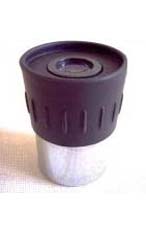 | Plössl
or "Symmetrical" The
Plössl was originally designed by Georg Simon Plössl in 1860, and several
versions can be found on the amateur astronomy market. By far the Plössl
eyepiece is currently the most widely used design. The name Plössl eyepiece
covers a range of eyepieces with at least four optical elements. Usually consisting
of two sets of doublets (a doublet lens is a convex and concave element sandwiched
together). Since the two doublets can be identical this design is sometimes called
a symmetrical eyepiece. The compound Plössl lens provides a large apparent
field of view along with relatively large FOV. This makes this lens ideal for
a variety of observational purposes including deep sky and planetary viewing.
The
chief disadvantage of the Plössl optical design is short eye relief, which
is restricted to about 70-80% of focal length. The short eye relief is more critical
in short focal lengths, when viewing can become uncomfortable.
Price range:
£14 - £70 each (for multiple-element or better eye-relief) | 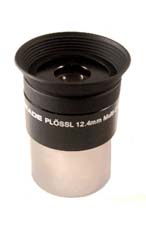 |
Multi-element
and SWA (Super-Wide Angle) eyepieces since 1979
Up to eight optical
elements in 4 or 5 groups. 70º FOV to 100º FOV.
Multi element eyepieces
can by expensive but if you have ever had an opportunity to look through
such a fine eyepiece then you will realise the huge advantage that these
can give both in relation to field of view and in the quality of the
image. TeleVue 'Nagler' and 'Ethos' eyepieces are the most expensive
on the market and can easily cost more than the telescope itself, with
some prices as high as £600 and above!
However, fine multi-element eyepieces do not always cost a fortune and
following are two highly recommended models to pursue if you have the
initial outlay
Price range: £90 - £140 each.
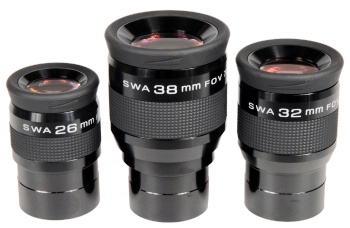 OVL PanaView
2" eyepieces
OVL PanaView
2" eyepieces | 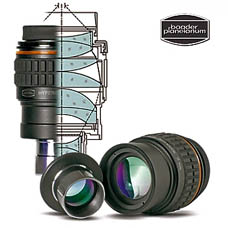 Baader
Hyperion 68 degree eyepiece Baader
Hyperion 68 degree eyepiece |
OVL PanaView
70° eyepiece
(Fits 2" barrels only)
OVL's 2” PanaView
5-element eyepieces with their impressive high-contrast super-wide views
are ideal for low power, deep-sky observing. Available in focal lengths
of 26mm, 32mm & 38mm, with apparent fields of view of 70° and
eye relief of 20mm, 24mm & 28mm respectively.
NB.
You will only ever need one of these in your collection so choose well, I find
the 32mm more than adequate, with the 38mm being far too heavy and cumbersome,
it is massive! The 32mm or the 26mm will give you the satisfying magnification
you need for low power observing and star-hopping.
Baader Planetarium
Hyperion 68° eyepiece
(Fits 2"
and 1¼" barrels)
The Baader Hyperion
eyepieces are one of the finest modular eyepieces out there, they will
fit 2" and 1¼" barrels and
have six elements (eight with the 1¼" extension) and are
modular, which means that you can vary the focal length by the addition
of optional fine tuning rings (FTR's), however, one or two well-chosen
eyepieces will serve you extremely well as these pieces also 'Barlow'
very well. (i.e. they can be used to great effect with a x2 Barlow lens).
However, using the FTR's in the dark with cold fingers is a tricky business
and not so good.
This means that
if you had say a 24mm and an 8mm, these would Barlow down to a 12mm
and a 4mm, which gives a very satisfying viewing range, as well as fantastic
eye relief. NB. the
24mm cannot be modified by the FTR's, but all others in the series can.
The Baader Hyperions
do not work so well in fast scopes, f/5 and faster, so avoid these if
you have a fast scope.
The Hyperion is a
comfortable eyepiece with a large field of view that is easily visible
even with eyeglasses. A field of view of 68 degrees is regarded as ideal
for astronomical observations and is the largest field of view that
can be viewed without strain and without turning your eyes.
They come in the following sizes: 3.5mm, 5mm, 8mm, 10mm, 13mm, 17mm,
21mm, 24mm
|
Recap....
There are 11 or 12 different designs of eyepieces, however, some
earlier designs have now fallen out of use because of the advent
of advanced technology and the improved multi-coatings used to
disperse false colour and to give sharper fields of view. Improvements
such as multi-element eyepieces improve the quality of the image
considerably and a field of view (FOV) of 50º and above is
considered good.
Various designs
in eyepieces offer different qualities of FOV and eye relief,
and some eyepieces work better with faster telescopes whilst others
work better in long focal length telescopes (or apertures) such
as SCT's (Schmidt Cassegrain Telescope). Generally speaking, wide
angle eyepieces with low magnification work better in faster scopes
(f/5) whilst high magnification for planetary use work better
in focal lengths f/6 and above. However, owners of fast scopes
will have a range of good high magnification eyepieces in their
armoury, but will choose eyepieces with good eye relief and multiple
elements as a preference to aid comfortable viewing.
|
Part
Four: Now that I know all about eyepieces, where do I start?
The least you
can do without upgrading....
Assuming that your
telescope came with one or two eyepieces (a 25mm and a 10mm), the first
thing is to buy a 2x Barlow Lens, this doubles the maginification of
the eyepieces you already have, so your 25mm becomes a 12.5mm and your
10mm becomes a 5mm. The next thing you should consider is to buy a Moon
Filter so that you can explore the Moon for long periods at a time.
A moon filter is not essential, but aids more comfortable viewing. It
is recommended here that you should buy a ND96 (0.9 or 0.6) Moon filter
(The 0.9 and 0.6 by the way refers to the density, the higher the number,
the more density. A low density for use with smaller aperture telescopes
and a higher density for large apertures, suggest 0.09 for large apertures
above 6" and 0.06 for small apertures below 6" - light transmission
13% and 25% respectively), the ND means Neutral Density and therefore
optics do not add any false colourization, whereas some Moon filters
have a colour bias (usually green). A Barlow lens will cost between
£18 & £28, and an ND96 (0.9 or 0.06) filter about £15.
| Hot
Tip: When buying a Moon filter, always try and buy a metal-framed
one, the plastic frames tend to be difficult to screw on in the
dark! (ND filters are usually made from metal frames.) |
If you want to stop
here then this is the least you need to do to expand your enjoyment
of the sky at night.
Upgrading
your eyepieces
By far
the most popular eyepieces is the Plössl eyepiece, there are a
number of reasons for this but the principle ones are as follows:
- they have a wider FOV than the orthoscopic, however,
less than the Konig
- Plössl
multi-coatings
are continually being improved and include blackened edges, not
so with the Kellner, Konig or MA's
- They
come in four, five and six-element designs, improving in quality all the while,
not so with the Kellner, Konig
or MA's
- their
popularity has led to lower prices leading to improved affordability, whereas
a good ortho can set you back £80
There are good Plössls and
not so good. The best advice is to stick to branded Plössls, such as Celestron,
Sky Watcher, Meade, Williams Optics, Orion or Baader Planetarium and so on.
Decide
on your price range and individual requirements
In
most cases amateur astronomers will want to start with the most affordable designs
that gives the best value for money, and in my book there is no finer design than
the four-element Celestron Plössl eyepiece. Individually these cost between
£14 and £30, and in my mind are the sharpest, clearest eyepieces both
for wide sky (the 32mm) and for Lunar and planetary work (6mm etc). They also
suit fast scopes around f/5 but are even better on f/6 and above, along with SCT's.
The
following focal lengths are recommended: 32mm; 15mm; 9mm; 6mm - note how when
you Barlow these there is no duplication of sizes, so Barlowed, these would give
you a range of 8 focal lengths!
However, if
you have a limited budget then I would recommend the 32mm and
the 9mm to start. These would Barlow down to 16mm and 4.5mm, a
perfectly satisfying range for most types of viewing. The illustration
opposite shows the very fine Celestron 32mm Plössl, very
much recommended.
Sky-Watcher and the Meade 4000 Series Plössl's also offer
very good value for money but are a little more expensive than
the Celestron, but good clear views. The Meade 5000 Series are
even better!
| |
Hot
Tip: Where you are aware that eye relief is not of a premium (such as in the
higher magnifications of the Celestron Plössls, for example), Barlow a lower
power eyepiece instead, that way you get the higher magnification as well as better
eye relief! So if you want 15mm maginifcation for example but better eye relief,
Barlow the 32mm to give you 16mm instead! |
Six elements
means excellent viewing - the Meade 5000 Series HD-60's
If good eye relief and sharper images are of premium, and you want
to upgrade to a finer eyepiece then the Meade 5000 Series HD-60
eyepieces offer great veiwing potential.
The latest advancement
in the Meade Series 5000 eyepiece series offers a large 60°
apparent field of view and a flat field of view which is tack sharp
right to the edge. This design provides more than 17mm of eye relief
for terrific viewing comfort while simultaneously delivering a 40%
improvement in corrections for chromatic aberration and edge distortions
over traditional Plössls.
Meade Series
5000 Plössl Eyepieces offer a very wide field-of-view, with
pinpoint edge of field sharpness and contrast. Specifications
of this advanced design include a six element, super fully multi-coated
optical design with premium-grade and exotic optical glass for
the best possible performance and image brightness and blackened
lens edges for enhanced contrast.
Features a
precision manufactured 1.25" barrel, increased eye relief
and an adjustable twist-up rubber eyeguard for comfort and blocking
stray light.
Focal lengths
available: 4.5mm, 6.5mm, 9mm, 12mm, 18mm, 25mm. The eyepieces
are parfocal with the exception of the 18mm and 25mm models.
UK price,
around £86 each
|
|
Orthoscopic
Eyepieces
Orthoscopic
eyepieces are rather more specialist than the Plössl and are really designed
for planetary viewing and long focal length telescopes, though they can be used
effectively in reflectors of shorter apertures, but try them out first. 'Orthos'
as they are called used to be the more popular eyepieces some years ago before
improved multicoatings arrived and the popularity of the Plössls.
Because
of its narrower FOV - 40°-50° they do not compare quite as well to the
Plössl, and because of the narrower FOV their focal lengths would normally
range from 2.5mm to no greater than 18mm, as they are not to be considered for
wide field (deep-sky) astronomy. Orthos can be of mixed quality so talk to other
people about them before committing to a purchase.
The following are illustrations
of some current orthos on the market, they have varying degrees of quality but
obviously the reputation and quality of the Baader Genuine Ortho is undisputable,
but if you want to try a cheaper one which will give perfectly good results in
an f/6 telescope (or greater), then the Kson is well worth a try at around £25.
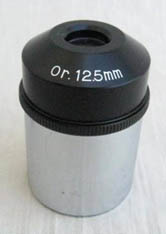 The
classic Celestron ortho,
The
classic Celestron ortho,
this was a starter eyepiece
and not recommended
now | 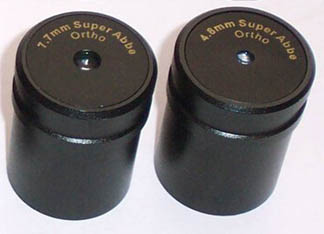 This is an
offering from Kson based in Guangdong,
This is an
offering from Kson based in Guangdong,
China, they come
in five focal legnths and the quality is
reasonable. More field testing would
be advantageous |
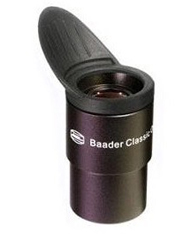 The
excellent Baader Planetarium
The
excellent Baader Planetarium
Classic Ortho |
|
And finally....featured
eyepiece.....BST StarGuider
- 60 degree ED eyepiece 1.25" fitting
This eyepiece has proved very popular with amatuer astronomers,
and at a price from around £55, it is unbeatable for performance
as a middle of the range eyepiece.
The eyepiece
uses two separate ED (Extra-low Dispersion) glass elements of
different glass types in its optical system to provide exceptional
colour fidelity (with astonishingly low levels of chromatic aberration)
so that the true colour differences between binary star pairs
and planetary surface details are easily visible. It has a 60°
field of view which is very flat and it is particularly recommended
with telescopes with a f/5, or greater, focal ratio. It is uniformly
sharp edge-to-edge, with markedly low astigmatism. Barrel distortion
is essentially non-existent, eliminating the annoying "goldfish
bowl" effect of distortion of the image which is often seen
in some eyepieces when panning across a star field.
Each air-to-glass
surface in the Explorer eyepiece is fully multicoated for high
light transmission and exceptional contrast. This high contrast
makes it a good choice for splitting close binary stars, for examining
low contrast lunar and planetary detail, and for finding small
and faint planetary nebulae against a truly dark sky background.
The lens edges are blackened to eliminate internal reflections
and further improve contrast. As you would expect, the chrome
barrel is threaded for standard 1.25" filters and has a capture
ring to help reduce the chances of accidently dropping the eyepiece
out of the focuser.
Explorer eyepieces
are parfocal, minimizing the amount of refocusing needed when
changing eyepieces within the series.The eyepiece is set in a
heavy rubber cladding which is grooved for easy grip. It has a
soft rubber twist up eyecup which will make it unbelievably convenient
to those of us who wear spectacles.
The colour
coded body rings and clear lettering print will help you find
the right one in the dark. The eye lens is large in diameter (see
photo) and with 13mm eye relief this makes it very comfortable
and easy to look through.
It weighs
6.4 ounces.
Can be bought
from Sky's
the Limit or
First
Light Optics
|
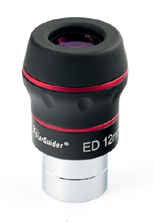
The BST
StarGuider ED,
highly recommended
|
|
Recap....
There
are a number of different types of eyepieces on the market. But generally speaking
the improved multi-coated Plössls are currently the best eyepieces for both
planetary and lunar use, as well as deep sky (the 32mm being the best for deep
sky).
Stick to branded eyepieces such as Celestron, Meade, Sky Watcher,
Baader, Williams Optics, Orion, and of course TeleVue and Pentax if money is no
object!
Do
not buy eyepieces with identifying features that you do not understand, and avoid
the following types that begin with letters such as SR (Symmetric Ramsden), H
(Huygens) or K (Kellner). These are basically starter eyepieces.
Multiple
element eyepieces (5 elements and above) should give you better and sharper views,
as well as better eye relief. Remember that these will inevitably cost you more,
but quality of viewing is key to the enjoyment of astronomy. |
I do hope the above
notes have been useful, if you would like to discuss any of the information
contained in this article please feel free to do so by emailing the
administrator at Robin
Wilkey
Further articles:
Ed Ting (You
Tube): The
Only 2 Eyepieces I Use - Which Are They?
How to choose
eyepieces CLICK
HERE
Telescope Eyepiece Fundamentals CLICK
HERE
Types of eyepieces
and their history CLICK
HERE
Chris Lord ‘The Evolution of Astronomical Eyepieces’ CLICK
HERE
How to calculate
eyepiece magnification and TFoV etc: CLICK
HERE
|





